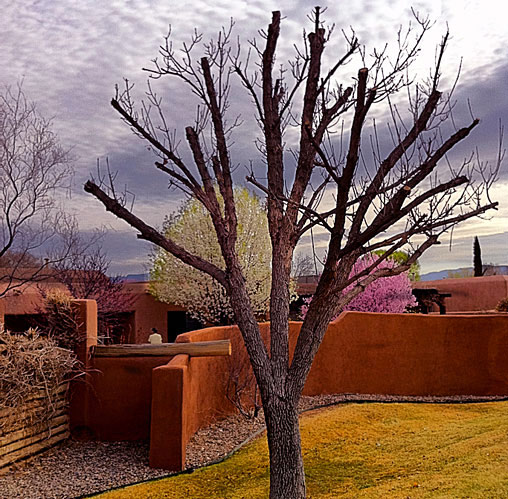“Tree-topping” is a four-letter word

If you’ve ever seen a tree that has been topped you’ll know what I’m talking about. On my way home every day I cross the Rio Grande and the silhouettes of the Rio Grande Valley Cottonwoods against the beautiful setting sun is a sight to behold. The intricate branch structure is revealed in all it’s detailed glory. So when I see an urban tree that has been topped, it gives me spine shivers.
There are untrained tree workers that still believe that the topping of trees is acceptable or even good for trees. They see the flush of sucker growth as a sign of vitality. Little do they know how harmful it is from a biological and structural standpoint.
First, from a biological perspective, when a tree is topped it loses it’s ability to produce food and carry on respiration, similar to having your lungs cut out of your body. At that point the tree is in a race against the clock. It needs leaves to produce food through the process of photosynthesis to carry on life functions. The tree has to draw heavily on energy reserves to regrow the canopy, the leaf surface area. If those energy reserves are low due to insect infestations, drought, or repeated years of topping, the tree’s defenses are weakened against insect, disease, or drought, which could lead to death of the tree in severe cases.
Second, topping removes all the natural branches which have a very strong attachment. After a tree has been topped, all of the new growth are suckers. Suckers are produced as a survival strategy by the tree. Suckers are produced from dormant or latent buds and are superficially attached. It is because of this poor attachment we see many limb failures years after the topping was performed.
Decay and insects are another biological consequence. Making large cuts at indiscriminate locations on the branches or stems, where the tree does not have the ability to close off the wound, leads to decay. This is the point where the new “branches” suckers will be forming. It’s like building a sky scraper on swamp land. Sooner or later it’s going to fall. In most cases, we would classify a topped tree as hazardous! In some cases, depending on the species or severity of the topping, we can perform corrective pruning to try and restore the structural integrity of the tree, but rarely can we restore the natural beauty.
Trees can be a work of natural art to be enjoyed. Sometimes they need a little help from a professional arborist to correct a defect or clean out the deadwood. All pruning should be done to improve the health, and natural beauty of your trees so that they can be enjoyed for many years.
So get out and take a walk around your neighborhood in the evening, and take in the beauty of all the different trees beautifully silhouetted against New Mexico’s painted sunsets.


